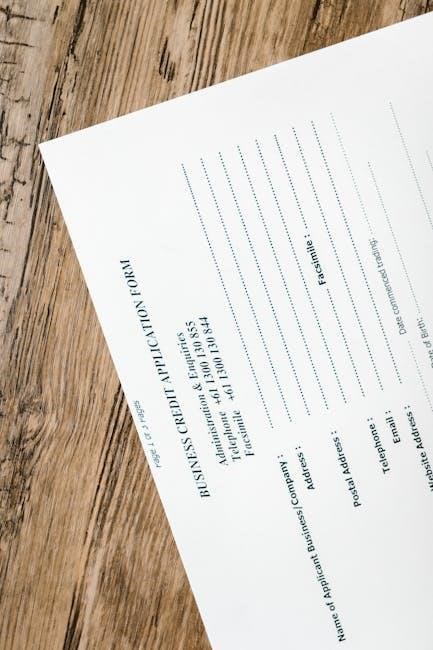
Understanding Form 1099-PATR: Overview and Purpose
Form 1099-PATR is used by cooperatives to report patronage dividends, nonpatronage distributions, and other taxable distributions to their members․ It helps members report income on their tax returns accurately․
What is Form 1099-PATR?
Form 1099-PATR, Taxable Distributions Received From Cooperatives, is an IRS tax form used by cooperatives to report distributions paid to their members․ It includes patronage dividends, nonpatronage distributions, and per-unit retain allocations․ The form is issued to members who received at least $10 in taxable distributions or had federal income tax withheld․ It provides details necessary for members to report income on their tax returns accurately․ This form is essential for transparency and compliance with tax regulations․
Purpose of the Form
The purpose of Form 1099-PATR is to provide members of a cooperative with a record of taxable distributions they received during the tax year․ It ensures that income from patronage dividends and other distributions is accurately reported to the IRS․ The form helps members determine their taxable income and claim any eligible deductions or credits․ It also enables the cooperative to comply with IRS reporting requirements, ensuring transparency and accountability in financial transactions between the cooperative and its members․
Who Needs to File Form 1099-PATR?
Cooperatives are required to file Form 1099-PATR for each member who received at least $10 in patronage dividends or other taxable distributions during the tax year․ This includes payments made in cash, property, or other forms of compensation․ Additionally, if federal income tax was withheld under backup withholding rules, the cooperative must file the form regardless of the payment amount․ The form is essential for ensuring that all taxable distributions are reported to the IRS and that members have the necessary documentation for their tax returns․

Key Elements of Form 1099-PATR
Form 1099-PATR includes boxes for patronage dividends, nonpatronage distributions, and per-unit retain allocations․ Each box represents specific income or credits distributed to cooperative members, ensuring accurate tax reporting․
Boxes and Their Meanings
Form 1099-PATR contains specific boxes that detail distributions made to cooperative members․ Box 1 reports patronage dividends, which are rebates based on purchases․ Box 2 shows nonpatronage distributions, profits not tied to member purchases․ Box 3 indicates per-unit retain allocations, payments held from sales․ Box 4 includes federal income tax withheld, while Box 5 notes state or local withholdings․ Each box provides clarity on the type of distribution, ensuring accurate tax reporting for members․

Patronage Dividends and Other Distributions
Patronage dividends are payments made by cooperatives to members based on their purchases or business conducted with the cooperative․ These dividends are reported in Box 1 of Form 1099-PATR․ Other distributions, such as nonpatronage dividends, are also included and reported in Box 2․ These distributions may be taxable and must be reported on the recipient’s tax return․ The form ensures transparency in income reporting, helping members accurately account for cooperative-related income when filing their taxes․
Nonpatronage Distributions and Per-Unit Retain Allocations
Nonpatronage distributions are payments made by cooperatives to members for activities not directly related to their patronage, such as investments or other business dealings․ These are reported in Box 2 of Form 1099-PATR․ Per-unit retain allocations, shown in Box 3, represent amounts withheld by the cooperative to cover expenses or losses; These allocations may be taxable and must be reported on the recipient’s tax return․ Accurate reporting of these distributions ensures compliance with IRS requirements and proper tax accounting for cooperative members․
Filing Requirements and Deadlines
Cooperatives must file Form 1099-PATR if they paid $10 or more in patronage dividends or distributions․ The deadline is January 31st; late filing may result in penalties․
Threshold for Filing

Cooperatives must file Form 1099-PATR if they paid $10 or more in patronage dividends or other taxable distributions to a member during the calendar year․ This threshold applies to both patronage and nonpatronage distributions․ Additionally, if federal income tax was withheld from any distribution, regardless of the amount, the cooperative must also file Form 1099-PATR․ This ensures accurate reporting of taxable income to the IRS and helps members comply with their tax obligations․ Understanding this threshold is crucial for proper compliance with IRS regulations․
Important Filing Deadlines
The deadline to provide Form 1099-PATR to recipients is January 31st of each year․ The form must be filed with the IRS by February 28th (or March 31st if filing electronically)․ Missing these deadlines can result in penalties; Ensure timely submission to avoid IRS issues and maintain compliance․ Proper filing ensures accurate reporting of taxable distributions and helps recipients meet their tax obligations․ Cooperatives must adhere to these deadlines to fulfill their legal requirements and avoid potential fines or delays in processing․
Consequences of Late Filing
Late filing of Form 1099-PATR can result in penalties from the IRS․ The penalty amount depends on how late the form is filed, with higher penalties for longer delays․ If filing is more than 30 days late, the penalty increases, and after August 1, the penalty is $290 per form․ A maximum annual penalty applies if the failure to file is due to intentional disregard․ The IRS may reduce penalties if reasonable cause is shown․ Late filing can lead to additional IRS scrutiny and complications, so timely submission is crucial to avoid these consequences․

Step-by-Step Instructions for Completing Form 1099-PATR
Start by entering recipient and payer details․ Next, fill in boxes with patronage dividends and distributions․ Finally, sign and certify the form for submission․
Completing Recipient and Payer Information
Start by entering the recipient’s name, address, and Taxpayer Identification Number (TIN) in the designated fields․ Provide the payer’s name, address, and TIN as well․ Ensure accuracy, as incorrect information may delay processing․ Double-check the details to avoid errors․ The payer’s Employer Identification Number (EIN) is also required․ Verify all entries for completeness and correctness before proceeding to other sections of the form․ Accurate recipient and payer information is crucial for proper IRS reporting and timely processing․
Filling in the Boxes: A Detailed Guide
Complete each box carefully, ensuring accurate reporting of distributions․ Box 1 reports patronage dividends, which are taxable․ Box 2 includes nonpatronage distributions, also taxable․ Box 3 shows per-unit retain allocations, which may be non-taxable․ Box 4 indicates federal income tax withheld, while Box 5 reflects state tax withheld and the state code․ Allocate amounts correctly to each box, as this determines the taxable income reported to the IRS․ Ensure all entries are precise to avoid filing errors or delays․
Signing and Certifying the Form

Ensure the form is signed and dated by the payer or authorized representative․ The signature confirms the accuracy of the information reported․ Keep a copy for your records, as the IRS requires proof of timely filing․ Failure to sign or certify may result in processing delays or penalties․ Verify all details before submission to ensure compliance with IRS guidelines and avoid potential issues․
Reporting Form 1099-PATR Income on Your Tax Return
Report patronage dividends and nonpatronage distributions from Form 1099-PATR on Schedule C or F․ Some distributions may not be taxable, depending on the cooperative’s structure and IRS rules․
How to Report Patronage Dividends
Patronage dividends from Form 1099-PATR are generally reported as income on Schedule C or Schedule F, depending on the type of business․ If you received patronage dividends, report the amount shown in Box 1 of the form․ If the dividends are related to farming, use Schedule F․ Some patronage dividends may be eligible for deduction as a business expense, reducing taxable income․ Always follow IRS guidelines and consult instructions for specific reporting requirements to ensure compliance with tax regulations․
How to Report Nonpatronage Distributions
Nonpatronage distributions from Form 1099-PATR should be reported separately from patronage dividends․ Typically, these distributions are taxable income and should be included on Schedule C or Schedule F, depending on whether they relate to a business or farm operation․ Review the instructions for Form 1099-PATR to identify the specific boxes that pertain to nonpatronage distributions․ Ensure compliance with IRS guidelines for accurate reporting and consult official resources for detailed instructions․
Special Considerations for Farm Income

Farm income reported on Form 1099-PATR requires careful handling․ Patronage dividends and nonpatronage distributions related to farm operations are typically reported on Schedule F․ Farm-related distributions may qualify for specific deductions or credits; Review the instructions for Form 1099-PATR to ensure accurate reporting of farm income․ Nonpatronage distributions may be treated differently than patronage dividends․ Consult IRS guidelines for farm-specific tax reporting requirements and ensure compliance with all applicable rules to avoid errors or penalties․ Always verify the taxable status of distributions before filing․

Frequently Asked Questions About Form 1099-PATR
Form 1099-PATR is issued to report patronage dividends and taxable distributions from cooperatives․ Recipients often ask why they received it, if all distributions are taxable, and how to correct errors․
Why Did I Receive a Form 1099-PATR?
You received Form 1099-PATR because a cooperative paid you at least $10 in patronage dividends or other taxable distributions․ It reports income you must include on your tax return․
Are All Distributions Reported on Form 1099-PATR Taxable?
Not all distributions on Form 1099-PATR are taxable․ Patronage dividends are generally taxable, while nonpatronage distributions may be taxable depending on the cooperative’s structure and your membership status․
What If I Need to Correct a Form 1099-PATR?
If you need to correct a Form 1099-PATR, you must file a corrected version with the IRS․ Submit a new form with the accurate information and mark the “Corrected” box at the top․ Provide a copy to the recipient as well․ Address any errors promptly to avoid delays or penalties․ Ensure all details are accurate to maintain compliance with IRS requirements․
Additional Resources and IRS Guidance
Visit www․irs;gov for Form 1099-PATR instructions, updates, and related forms․ Utilize the IRS Free File Program and consult IRS publications for detailed guidance and support․
Where to Find Form 1099-PATR and Instructions
Form 1099-PATR and its instructions are available on the IRS website․ Visit www․irs․gov/forms-instructions to download the form and guide․ The IRS also provides updates, related forms, and filing tips․ For e-filing, use the IRS Free File Program at www․irs․gov/FreeFile․ Additional resources, such as IRS publications and support, are accessible online or by contacting the IRS directly․ Ensure compliance by referring to the official IRS guidance for accurate filing․
IRS Publications and Support
The IRS offers various publications and resources to assist with understanding and filing Form 1099-PATR․ Visit www․irs․gov for access to the form, instructions, and related guidance․ The IRS Free File Program at www․irs․gov/FreeFile provides free tax preparation tools․ Additional support is available through taxpayer assistance centers, the IRS help hotline, and online chat․ These resources ensure accurate filing and address common questions about taxable distributions from cooperatives․